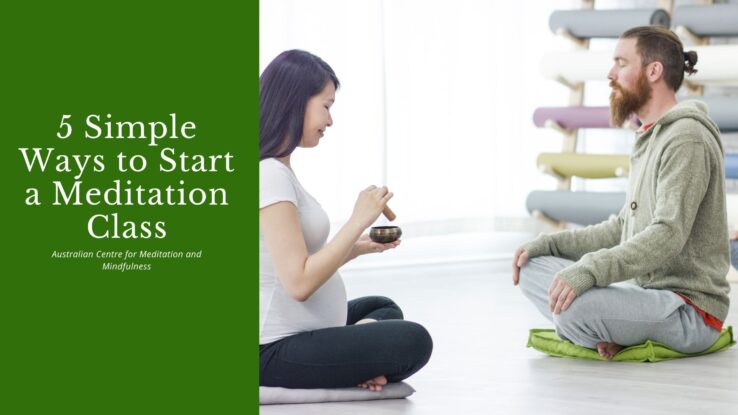5 Simple Ways to Start a Meditation Class
Do you want to start running your own meditation classes but are not sure where to start?
Starting a meditation class is exciting and a wonderful way to connect with like-minded people, develop your teaching skills and deepen your understanding and practice. But it can also be quite nerve wracking, especially if it is your first time.
With the state of work, the economy, politics, war, health, climate change, environmental degradation and myriad other global and local issues, people are feeling on edge, powerless and in need of compassion.
One way we can help is by bringing people together in a wholesome, respectful, and comfortable space of care, kindness, and interconnection; creating a precious time to experience the power of human connection, group meditation and to appreciate ourselves, life, and each other.
Starting a meditation class is enjoyable and rewarding and a great way to share useful tips, insights, skills, and practices. Perhaps this is something you would like to do but are not sure how to get started? If it is, there are many options, and the important thing is to start wherever feels most comfortable for you.
Assuming you are a qualified meditation teacher, and are interested in starting a meditation class, here are 5 simple ways to get started:

- Start a casual class at home for friends and family – many classes start with a small group of interested friends and family in someone’s home.
- Start a casual lunchtime (or other time), drop-in class at work.
- Start a Meetup class.
- Start an online class – online groups are great way to reach people who can’t attend in person.
- Start a community class – volunteer at your local community centre, not-for-profit, in your residential building or neighbourhood, in an aged-care facility, or a hospital. The possibilities are endless.
In all the above cases, when starting a meditation class, it can help to:
- Start small.
- Keep it simple. Don’t discount the value people gain from coming together in a nurturing group.
- Reach out and invite your friends, family, neighbours, colleagues, people you know and trust will be supportive as you build confidence and experience. (You might like to steer clear of any family or friends who are likely to be over-critical and undermine your confidence.)
- Make it accessible – outside/inside, affordable, all welcome, sit on chairs, free of dogma etc
- Decide on the class format. Will classes be stand alone, follow on in sequence or part of an overarching program? Will classes focus on a theme, a set of topics, or particular outcomes such a reducing stress? Will classes be ongoing or run in terms or a block of classes? Will classes run each week, fortnight, month, or how often? How long will each class run for? Who will your classes be for? Will you teach a number of techniques or focus on a particular approach, or style of meditation?
Here are some suggestions to make your classes really sparkle and add value to your group members:

- To teach something well you must really understand it, so teach and guide what you know and love. This will ensure your classes are authentic and engaging.
- Don’t feel like a failure if you only have one or two members. This is still beneficial, and many groups run well for years in small sizes. My group has dwindled down to 1 person (sometimes no-one) at times, and wow has that person loved the personal care and attention! Whoever attends (or doesn’t attend), it is always an opportunity for learning and developing.
- Will it be an open group where drop-ins are welcome? Or a ‘closed’ group where group members get to know and bond with each other over time and the door is only rarely open to new members?
- Will you volunteer your time, ask for donations or charge a fee?. (I find many people get more out of classes when they have paid or exchanged something for them.)
- Always be open to feedback and suggestions for improvements from your members.
- Learn and tweak as you go from experience. What felt good? What worked? What didn’t work? Be willing to adjust as you go, remembering that there is no such thing as perfect.
- Jump in and make a start! If you wait until you feel ready, you will likely never start! The best way to improve your class is to try, learn and adapt as you go.
Once you have considered the above factors, it’s time to drill down to the finer details.
Spread the Word
Once you have decided where you will start your class and who they will be for, set a regular time, place, and start date. Start small and let your class grow organically. Let people know via email, social media, flyers or posters. Encourage group members and friends to spread the word. You might let people know to wear comfortable clothing, bring some water, a blanket in the colder months, and to turn their phones and devices off or to silent.
The Space
Use a space that is comfortable, relatively quiet, and free from interruptions. Does the space have chairs, or will you ask people to bring their own cushion and/or mat. If starting an online class, choose an online platform that will give you enough time and space (digitally) to hold your class. Get any relevant permissions, book the space, put up a sign, and set the space up. 
Structure
Will you guide a meditation, sit in silence, share information, or teach any content? Will you discuss your practice, share a quote, story or reading, or simply chat with each other? Will you include mindful activities or movement? Will there be opportunities for journalling, chanting or walking mindfully together? If you have never participated in a meditation group or class, you might like to join one to enjoy their benefits for yourself and to see how running a meditation class can be done. The length and frequency of the class will depend on your plans for teaching and guiding and your groups interest in and availability for the class. Will it be a 30min, weekly class? Will it be a series of 6, 90 minutes sessions run over 12 weeks? The possibilities are endless.
Group Sharing
Group sharing is an important part of the meditation class, giving participants the opportunity to listen to and learn from each other’s experience, deepen compassion and cultivate awareness of their own experience, increasing connection, intimacy, learning and enjoyment. Sharing can be facilitated in many ways, can be open-ended or focused on a specific question or aspect of experience. In all cases, sharing should always be voluntary and compassionate silence is good too! To nurture the sharing experience, ensure the group is aware of and agree to your guidelines for group discussions such as respect for each other, active listening, confidentiality, brevity when speaking (mindful sharing), no advice-giving, no interruptions or crosstalk, no judgment, participate with an open mind and an open heart, and any other points that will help to create trust within the group.
If you have got this far, you’re doing well and you’re almost there! And no doubt your class will be of great benefit to your group members.
What does a basic meditation class structure look like?
 It will help to have consistency in your classes as this cultivates familiarity and can deepen experience for participants. Letting the group know the structure of the class from start to finish can also help to alleviate uncertainty and apprehension. Here is a basic structure that you can adapt to suit your class.
It will help to have consistency in your classes as this cultivates familiarity and can deepen experience for participants. Letting the group know the structure of the class from start to finish can also help to alleviate uncertainty and apprehension. Here is a basic structure that you can adapt to suit your class.
- Welcome everyone, reminder to turn phones, devices, and distractions off.
- Set the expectations and group guidelines.
- Share a quote or story or lesson/learning (keep it brief and relevant)
- Lead the group through a guided meditation
- Finish meditation and give participants time to reflect and readjust back to the group.
- Group Discussion – invite group sharing about their experience and anything that came up. Use your reflective listening skills and reiterate group rules.
- You might consider a closing action to end the class such as a saying, mantra, action or something else to formally end each class in unity and reverence.
Starting a meditation class can stretch you out of your comfort zone, but is deeply rewarding, so prepare as best you can and ENJOY!
Share your experiences with the ACMM community to learn from and grow with each other!
Did you know that when you enrol with ACMM you have the opportunity to join our Business Lounge?
The Business Lounge supports students and graduates to grow their business confidence and knowledge with resources, guidance, community and live events! It is open to ACMM students and graduates.
Not an ACMM student or graduate? We offer Certificate, Advanced Certificate and Diploma Training Options, with optional Business Development Support alongside and after your training. Click here to learn more.
Find out if our courses are the right fit for you. Book a Zoom Discovery Call with Lisa Forde, ACMM Founder today!




